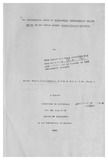| dc.description.abstract | The vervet monkey was susceptible to two stocks and a
clone of T. brucei. At a dose of 1 x 10"* inoculated parasites the
stocks killed the monkeys either in acute or chronic infection.
Also, the cloned parasite showed a dose-dependent response.
0
Monkeys died during acute infection when inoculated with 1 x 10
cloned trypanosomes. However, those inoculated with 5 x 10 or
1 x 10 3 parasites gave variable disease pictures and died either
during sub-acute or chronic infection particularly when
staphylococcal and streptococcal secondary infections supervened.
To effectively interpret the results in a T. brucei-infected
monkey it was first necessary to establish the normal parameters
for conventional cell-mediated responses in a normal uninfected
monkey. In the peripheral blood of the vervet monkey, T
(erythrocyte rosettes) and B (Stnlg) formed 70 and of 10% lymphocytes,
6 , respectively. Peripheral blood lymphocytes at 2 x 10 per ml,
responded optimally to non-specific mitogens, Con A and PHA but not
14
to LPS when cultured for 72 - 120 hours and pulsed with C-TdR for
16 hours terminally, as also did lymphocytes contained in ten-fold
diluted whole blood.
Meanwhile responder lymphocytes at 3 x 10 per ml were
optimally stimulated in an MLC type reaction with an equal
concentration of xenogeneic CLA^ cells when co-cultured for
168 hours and pulsed as above. The stimulation by allogeneic or
semi-xenogeneic cells from vervet monkeys or humans was poor.
The relationship between infection, treatment and self-cure
r ^ c t tn i"rr.Mne responses vas alco studied. After
immunization with tetanus toxoid, and 2, 4-dinitrochlorobenzene
(DNCB) monkeys were inoculated with 1 x 10^ trypanosomes.
Subsequently, their lymphocytes were tested in vitro with Con A,
PHA and xenogeneic CIA^ cells (in MLC); their DTH tested in vivo
with DNCB and their sera examined for specific (anti-trypanosome
and anti-tetanus) and non-specific (heterophile) antibodies.
Initially total IgM and heterophile antibodies were highly
elevated while the IgG levels were only slightly raised. Meanwhile
only the primary IgM (but not IgG) anti-tetanus antibodies and the
MLR were enhanced. Subsequently, in vitro Con A, PHA and MLC
lymphocyte responses, DNCB skin reactivity and both IgM and IgG
anti-tetanus antibodies were depressed through the course of
infections. Similarly, monkeys that survived the infection without
treatment also showed depressed cell-mediated immune parameters.
Berenil treatment restored quickly, within 3 days the
anti-tetanus antibody responses to normal. However, in vitro
Con A, PHA and MLC as well as in vivo skin responses reverted
to normal slowly after more than 30 days in the previously
T. brucej-infected monkeys. Berenil had no effect on the immune
responses of uninfected control monkeys.
Monkeys inoculated with 1 x 10 trypanosomes died of acute
infection within 2 - 3 weeks while showing depressed lymphocyte
responses to Con A and PHA. In the monkeys infected with
1 x 10^ trypanosomes self-cure occurred and cleared the parasitaemia
in the blood. However, self-cure did not abrogate the
immunodepression as evidenced by persistently depressed
stimulation indices from Con A-and PHA-stimulated lymphocytes
during the period of absence of detectable parasitaemia and 155
days after the start of the experiment. This suggested that the
trypanosomes were perhaps still present in some occluded sites
e.g. CNS or tissues, from where they probably exerted their
persistent immunodepressive effect.
During infection leucocytes and their sub-sets changed
numerically and proportionally. In monkeys inoculated with
8 4 1 x 10 or 1 x 10 trypanosomes leucopenia occurred accompanied
by lymphocytopenia, neutrocytosis and monocytosis. The
lymphocytopenia, was associated with low absolute erythrocyte
rosette (T) and surface membrane immunoglobulin-bearing (B) cells
and initially reduced but subsequently normal absolute "null" cell
counts.
The proportions of lymphocytes decreased while those of
neutrophils and monocytes increased, respectively. Normocytic
and hypochromic anaemia was the most prominent feature of
T. brucei infection in the vervets. It persisted in animals that
died of the disease but was abrogated by Berenil treatment and
self-cure both of which restored to normal the total counts and
subpopulations of leucocytes in the chronically infected animals. | en_US |



